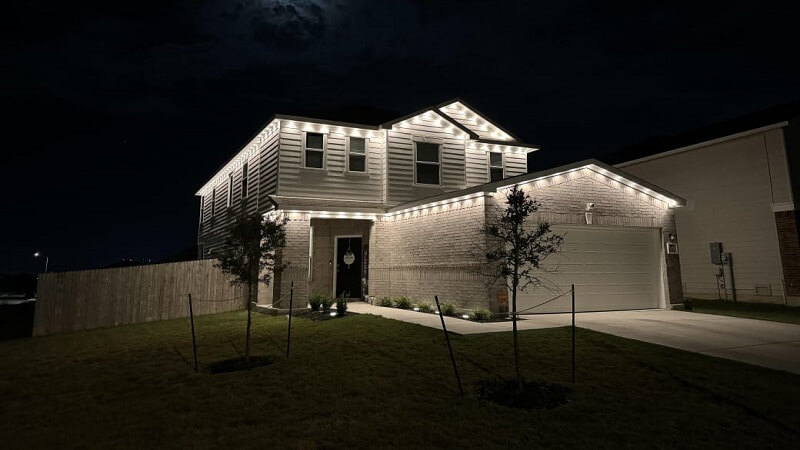When investing in permanent outdoor lights, one of the biggest concerns homeowners have is simple: Will they survive harsh weather?
Whether you live in a rainy region or deal with heavy snowfall every winter, your lighting system needs to stay strong, safe and fully functional.
The good news? Modern permanent outdoor lighting systems are engineered to handle tough weather conditions far better than traditional decor lights.
Let’s break down how these systems perform during heavy rain and snow and what makes them so reliable.
How Permanent Outdoor Lights Handle Heavy Rain
Most climates have rain and permanent outdoor lights have several safety layers, which maintain a smooth operation:
1. Sealed LED Bulbs
LED modules have tough casings that do not allow the penetration of moisture. This prevents short circuiting, flickering or breakage.
2. Waterproof Connectors
Weather-sealed housings are used in connectors, joints and wiring points to prevent corrosion and to shield against water exposure.
The waterproof connections render the modern permanent outdoor lighting very reliable, even when the rainy season is very long.
3. UV & Moisture-Resistant Coatings
Good lights have a material that does not corrode, fade, or weaken over time- thus the system can be used over several years.
A number of permanent lighting systems are designed to withstand a maximum of 10,000 hours of weather exposure.
Performance During Heavy Snow and Freezing Temperatures
Snow and ice create more difficulties, yet permanent lighting systems are developed to withstand winter, as well.
Contemporary configurations are designed as cold-weather lighting solutions, so that they can be relied upon to work effectively even in severe winter.
1. Freeze-Resistant LED Technology
LEDs also work well at low temperatures, unlike other bulbs, which are natural. Whereas conventional lights may fade or even break when freezing conditions lower the temperature, LEDs do not lose their brightness or efficiency even during low temperatures, hence making them a better choice in winter-proof LED systems.
2. Insulated Wiring
Professional outdoor lighting has insulated and heat-resistant wiring, which does not crack or become brittle in extreme cold. This makes your snow-resistant outdoor lights more useful even in areas with temperatures that are extremely cold temperatures.
3. Moisture Drainage Design
The melting of snow around the lights can bring about some temporary moisture, but the permanent lighting systems have drainage channels that do not allow water to accumulate and freeze around the parts. This design will facilitate cold-weather lighting service life.
4. Snow Load Compatibility
The bricks used to construct the houses are made to be able to bear the weight of the accumulated snow without bending, cracking, or losing balance. This renders snow-resistant outdoor lights reliable during heavy winter storms.
Safety Features That Keep Your Lighting Protected
Permanent systems are more concerned with safety, particularly during weather changes.
The new installations are created as storm-safe lighting systems, which allow the installations to maintain consistent operation even in extreme conditions.
Built-In Surge Protection
Geomagnetic storms tend to induce variation in power. Outdoor lights are also available permanently with surge protectors, which ensure the safety of your installation as reliable weather-protected electrical components.
Low-Voltage Systems
The majority of the modern systems are based on low-voltage outdoor lighting that lowers the heat levels, enhances safety and stability in the systems despite the damp environment. The low-voltage installation is particularly needed when it is raining or storming.
Automatic Shutoff Features
There are also more advanced designs that have smart controllers, which will sense an electrical problem and turn off the affected area, eliminating system failure. These are also installed protections that will ensure your lighting installation is all the more reliable as a storm-safe lighting solution.
Maintenance Tips for Weather Protection
Although permanent lighting is designed to have a long life, it can be helped to live even longer with the help of such simple measures:
- Before each major weather season, do a quick check for loose wires, cracked housings, or rusted mounts.
- Gently brush off heavy snow build-up, especially on roofline lights, to prevent stress on fixtures.
Smart lighting systems receive updates that improve performance and prevent glitches during extreme weather.
Final Thoughts
If you’ve been wondering how permanent outdoor lighting performs during heavy rain or snow, the answer is simple: extremely well.
Thanks to advanced waterproofing, durable materials, smart controls and cold-resistant LED technology, these systems stay bright, safe and dependable year-round.
Whether you’re dealing with monsoon rains, frosty winters, or unpredictable storms, permanent lights are designed to shine through it all, literally.

